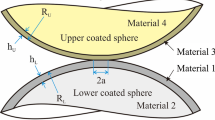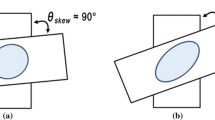Abstract
In the framework of the Johnson–Kendall–Roberts (JKR) theory, the adhesive contact between thin incompressible elastic coatings covering rigid cylinders is studied. The leading-order asymptotic model of three-dimensional non-axisymmetric JKR-type adhesive contact for a thin incompressible coating bonded to a rigid substrate is applied, and an approximate solution has been obtained under the assumption that the contact area remains elliptical.









Similar content being viewed by others
References
Johnson, K.L., Kendall, K., Roberts, A.D.: Surface energy and the contact of elastic solids. Proc. R. Soc. Lond. Ser. A 324, 301–313 (1971)
Johnson, K.L., Greenwood, J.A.: An approximate JKR theory for elliptical contacts. J. Phys. D Appl. Phys. 38, 1042–1046 (2005)
Liu, S.B., Peyronnel, A., Wang, Q.J., Keer, L.M.: An extension of the Hertz theory for three-dimensional coated bodies. Tribol. Lett. 18, 303–314 (2005)
Piwoński, I., Kisielewska, A.: Dialkyldithiophosphate acids (HDDPs) as effective lubricants of solgel titania coatings in technical dry friction conditions. Tribol. Lett. 45, 237–249 (2012)
Vendra, V.K., Wu, L., Krishnan, S.: Polymer thin films for biomedical applications. In: Kumar, C.S.S.R. (ed.) Nanomaterials for the Life Sciences, Vol. 5: Nanostructured Thin Films and Surfaces, pp. 1–54. Wiley-VCH Verlag GmbH & Co. KGaA, Weinheim (2011)
Aleksandrov, V.M.: Asymptotic solution of the contact problem for a thin elastic layer. J. Appl. Math. Mech. 33, 49–63 (1969)
Jaffar, M.J.: Asymptotic behaviour of thin elastic layers bonded and unbonded to a rigid foundation. Int. J. Mech. Sci. 31, 229–235 (1989)
Barber, J.R.: Contact problems for the thin elastic layer. Int. J. Mech. Sci. 32, 129–132 (1990)
Argatov, I.I.: Pressure of a punch in the form of an elliptic paraboloid on a thin elastic layer. Acta Mech. 180, 221–232 (2005)
Jaffar, M.J.: Prediction of the film thickness for the normal approach of a rigid sphere towards a thin soft layer. Tribol. Lett. 22, 247–251 (2006)
Argatov, I., Mishuris, G.: Frictionless elliptical contact of thin viscoelastic layers bonded to rigid substrates. Appl. Math. Model. 35, 3201–3212 (2011)
Argatov, I., Mishuris, G.: Contact Mechanics of Articular Cartilage Layers: Asymptotic Models. Springer, Cham (2015)
Yang, F.: Asymptotic solution to axisymmetric indentation of a compressible elastic thin film. Thin Solid Films 515, 2274–2283 (2006)
Hill, I.J., Sawyer, W.G.: Energy, adhesion, and the elastic foundation. Tribol. Lett. 37, 453–461 (2010)
Dickrell III, D.J., Sawyer, W.G.: Intermolecular forces, adhesion, and the elastic foundation. Tribol. Lett. 50, 245–260 (2013)
Popov, V.L., Heß, M.: Method of Dimensionality Reduction in Contact Mechanics and Friction. Springer, Berlin (2015)
Yang, F.: Adhesive contact between a rigid axisymmetric indenter and an incompressible elastic thin film. J. Phys. D Appl. Phys. 35, 2614–2620 (2002)
Argatov, I.I., Mishuris, G.S., Popov, V.L.: Asymptotic modeling of the JKR adhesion contact for a thin elastic layer. Q. J. Mech. Appl. Math. 69(2), 161–179 (2016)
Johnson, K.L.: Contact Mechanics. Cambridge University Press, Cambridge (1985)
Argatov, I., Mishuris, G.: Elliptical contact of thin biphasic cartilage layers: exact solution for monotonic loading. J. Biomech. 44, 759–761 (2011)
Shi, X., Zhao, Y.-P.: Comparison of various adhesion contact theories and the influence of dimensionless load parameter. J. Adhes. Sci. Technol. 18, 55–68 (2004)
Acknowledgments
IIA is grateful to the DAAD (German Academic Exchange Service—Deutscher Akademischer Austausch Dienst) for financial support during his stay at the TU Berlin. GSM acknowledges the EU project HORIZON2020 RISE Marie Sklodowska Curie grant MATRIXASSAY No 644175 for partial financial support during IIA’s visit to Aberystwyth University, where this research was completed.
Author information
Authors and Affiliations
Corresponding author
Appendix: Nearly Circular Contacts
Appendix: Nearly Circular Contacts
Let the interface gap be represented in the form
where we have introduced the notation
On the other hand, we will have
The two-term asymptotic expansion for the solution of the adhesive contact problem under the assumption that \(\mu \) is a small positive parameter was constructed in [18]. In particular, the polar equation for the contact contour was obtained in the form \(r\simeq a_0+\mu a_2\cos 2\theta \), where \(r,\theta \) are polar coordinates, so that the major and minor semi-axes are
respectively, whereas the aspect ratio of the contact area is given by
Here, \(a_0\) is the leading-order approximation as \(\mu \rightarrow 0\), and \(a_2\) is given by the formula
while (see also Eq. (22))
Let us now compare the asymptotic solution (36) with the approximate solution constructed above. First, from the second and third equations (15), we derive the equation
which, in view of (33) and (35), implies
At the same time, the first equation (15) can be rewritten as
where the first formula (34) was already taken into account.
The substitution of (35) and (38) into Eq. (39) results in the equation
which, after eliminating \(\delta \) by means of Eq. (37), reduces to Eq. (36).
Thus, in the case of a nearly circular area of contact, the obtained approximate solution agrees with the asymptotic solution up to the second-order terms. This, in particular, means that the adopted approximation for the contact pressure (5) is asymptotically exact for nearly circular contacts. On the other hand, the asymptotic ansatz developed in [18], which was established for an arbitrary smooth gap function close to a paraboloid of revolution, may suggest a more elaborate approximation (incorporating more free parameters) in order to extend the analytical approach to the range of smaller values of the ratio \(\rho \).
Rights and permissions
About this article
Cite this article
Argatov, I.I., Mishuris, G.S. & Popov, V.L. An Approximate JKR Model of Elliptical Contact Between Thin Incompressible Elastic Coatings Covering Rigid Cylinders. Tribol Lett 64, 12 (2016). https://doi.org/10.1007/s11249-016-0746-z
Received:
Accepted:
Published:
DOI: https://doi.org/10.1007/s11249-016-0746-z




